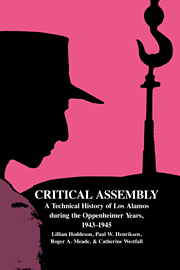Book contents
- Frontmatter
- Contents
- List of Illustrations
- Preface
- 1 Introduction
- 2 Early Research on Fission: 1933–1943
- 3 The Early Materials Program: 1933–1943
- 4 Setting Up Project Y: June 1942 to March 1943
- 5 Research in the First Months of Project Y: April to September 1943
- 6 Creating a Wartime Community: September 1943 to August 1944
- 7 The Gun Weapon: September 1943 to August 1944
- 8 The Implosion Program Accelerates: September 1943 to July 1944
- 9 New Hopes for the Implosion Weapon: September 1943 to July 1944
- 10 The Nuclear Properties of a Fission Weapon: September 1943 to July 1944
- 11 Uranium and Plutonium: Early 1943 to August 1944
- 12 The Discovery of Spontaneous Fission in Plutonium and the Reorganization of Los Alamos
- 13 Building the Uranium Bomb: August 1944 to July 1945
- 14 Exploring the Plutonium Implosion Weapon: August 1944 to February 1945
- 15 Finding the Implosion Design: August 1944 to February 1945
- 16 Building the Implosion Gadget: March 1945 to July 1945
- 17 Critical Assemblies and Nuclear Physics: August 1944 to July 1945
- 18 The Test at Trinity: January 1944 to July 1945
- 19 Delivery: June 1943 to August 1945
- Epilogue
- 20 The Legacy of Los Alamos
- Notes
- Name Index
- Subject Index
4 - Setting Up Project Y: June 1942 to March 1943
Published online by Cambridge University Press: 31 March 2010
- Frontmatter
- Contents
- List of Illustrations
- Preface
- 1 Introduction
- 2 Early Research on Fission: 1933–1943
- 3 The Early Materials Program: 1933–1943
- 4 Setting Up Project Y: June 1942 to March 1943
- 5 Research in the First Months of Project Y: April to September 1943
- 6 Creating a Wartime Community: September 1943 to August 1944
- 7 The Gun Weapon: September 1943 to August 1944
- 8 The Implosion Program Accelerates: September 1943 to July 1944
- 9 New Hopes for the Implosion Weapon: September 1943 to July 1944
- 10 The Nuclear Properties of a Fission Weapon: September 1943 to July 1944
- 11 Uranium and Plutonium: Early 1943 to August 1944
- 12 The Discovery of Spontaneous Fission in Plutonium and the Reorganization of Los Alamos
- 13 Building the Uranium Bomb: August 1944 to July 1945
- 14 Exploring the Plutonium Implosion Weapon: August 1944 to February 1945
- 15 Finding the Implosion Design: August 1944 to February 1945
- 16 Building the Implosion Gadget: March 1945 to July 1945
- 17 Critical Assemblies and Nuclear Physics: August 1944 to July 1945
- 18 The Test at Trinity: January 1944 to July 1945
- 19 Delivery: June 1943 to August 1945
- Epilogue
- 20 The Legacy of Los Alamos
- Notes
- Name Index
- Subject Index
Summary
By the time a fast-neutron fission laboratory was conceived early in 1942, theorists and experimentalists had made initial calculations for the bomb, including new estimates of critical mass and efficiency. Some progress had been made on designing methods for assembling the weapon and on a program for measuring nuclear constants central to bomb calculations. On the whole, however, research languished because of poor information exchange among the various groups involved, which were scattered throughout the United States. Oppenheimer, who replaced Gregory Breit as coordinator of the fast-fission project, recommended to Groves that the effort be centralized. Groves, who recognized the security benefits of centralization, readily complied, thereby setting in motion plans for establishing the Los Alamos Laboratory.
Groves and Oppenheimer took the first step toward creating the laboratory in early 1943 by recruiting many of the world's best scientists. The temporary nature of the project and the urgency of its mission aided the recruitment effort, but the task was complicated by the delicate issue of whether Los Alamos would be a military or a civilian establishment – an issue never formally resolved. The standard caricature of Oppenheimer as an other-worldly intellectual and Groves as a burly martinet highlights the misalignment between the military and scientific communities that joined in Project Y. Surprisingly, Oppenheimer and Groves developed a collaboration that was both congenial and fruitful.
- Type
- Chapter
- Information
- Critical AssemblyA Technical History of Los Alamos during the Oppenheimer Years, 1943–1945, pp. 40 - 66Publisher: Cambridge University PressPrint publication year: 1993

